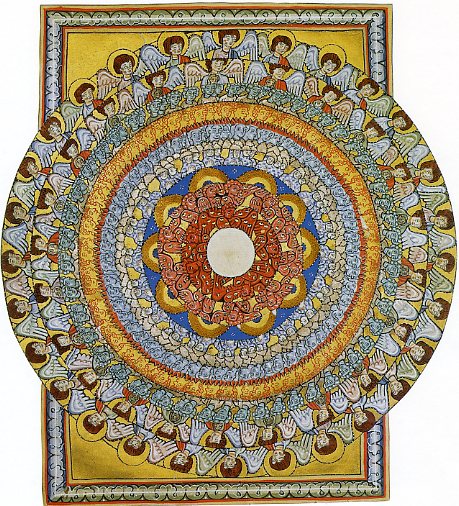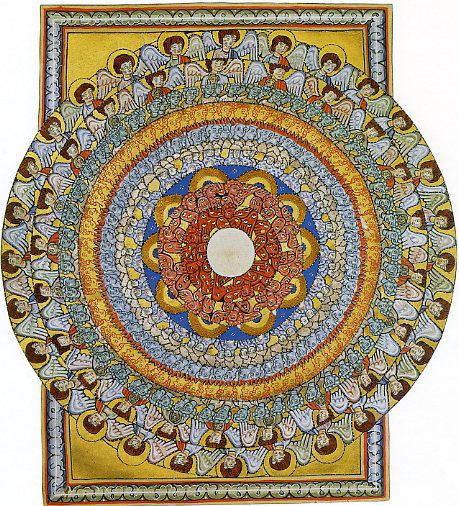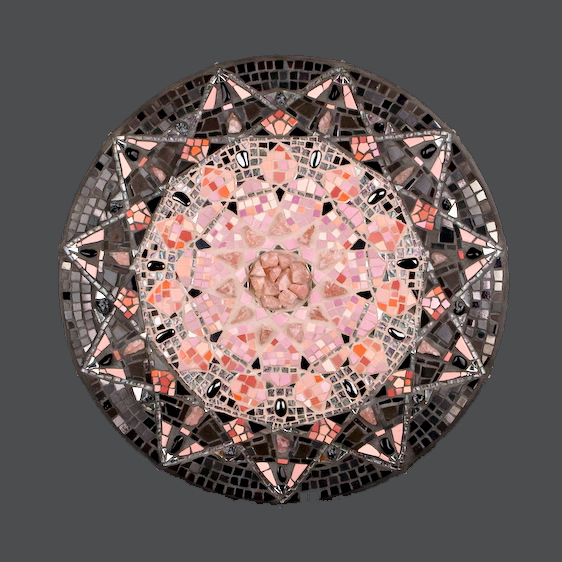As a child, I often saw or felt ‘entities’ from other worlds. Many children report supersensory experiences and one such child was Hildegard von Bingen.
 Hildegard of Bingen, (1098-1179) was born a tenth child to a German noble family. She was an influential and spiritual woman whose fierce devotion paved the way for future generations of women to succeed in fields from theology, to medicine, to music and art. At a very early age she claimed to experience supernatural visions of a powerful, transformative light, but she hid her prophetic abilities until much later in life. She was admitted into a convent at the age of eight, and was prepared for a life of hermetic devotion and meditation.
Hildegard of Bingen, (1098-1179) was born a tenth child to a German noble family. She was an influential and spiritual woman whose fierce devotion paved the way for future generations of women to succeed in fields from theology, to medicine, to music and art. At a very early age she claimed to experience supernatural visions of a powerful, transformative light, but she hid her prophetic abilities until much later in life. She was admitted into a convent at the age of eight, and was prepared for a life of hermetic devotion and meditation.

Hildegard’s Awakening, a self portrait
Although Hildegard was not formally educated, her desire to record her visions and messages into book form was undeterred. She relied on secretaries to help transcribe her ideas onto paper and was a prolific writer on topics of philosophy, herbal medicine, the natural world, and a noted composer of hauntingly beautiful chants.
Hildegard became a well-regarded authority and the Mother Superior of her convent. Around 1135, at age 42, she undertook a series of visionary symbolic paintings in unmistakable mandala-forms. While she did not make the illustrations herself, it is thought that she oversaw their production. These cosmic memories occur in myth and archetypes we readily recognize. The pictures were thought to be as strong or stronger than the words themselves. There is a gesltalt immediacy, what Hindu’s refer to as darshan, meaning the simultaneous act of seeing and being seen by a deity.

Universal Man. Manuscript illumination from Liber divinorum operum or De operatione dei (Book of Divine Works) by Hildegard of Bingen, 1163–74. Biblioteca Statale, Lucca
Hildegard can be seen sitting in the lower left corner of the illumination depicted above, receiving her visions in order to “art direct” her scribes and illuminators to her demanding standards. There is a drawing, or illumination, in her manuscript Scivias (Know the Ways), circa 1140–50, of her defining vision, in which the great span of the universe revealed itself to her in a trance as “round and shadowy…pointed at the top, like an egg…its outermost layer of a bright fire.”

Das Weltall. Manuscript illumination from Scivias (Know the Ways) by Hildegard of Bingen (Disibodenberg: 1151)

Die wahre Dreiheit in der wahren Einheit. Manuscript illumination from Scivias (Know the Ways) by Hildegard of Bingen (Disibodenberg: 1151)
Hildegard’s visions led her to channel cosmic laws into illuminations and illustrate invisible concepts such as ethers, air, and wind. She assigns meaning to these elements to represent such virtues as atonement, righteousness, and moderation.

Cultivating the Cosmic Tree
Central to her mandala paintings is the understanding of a ‘cosmic equilibrium’ and a reverence for all life. In her use of ‘quartering of the circle’ we recognize the four elements (fire, air, water and earth), an archetypal depiction also used by Native American sand painters for the four sacred directions. Her concept of Viriditas, the Greening, was a precursor to our ecology movement. She described this power as the agent of the God, a divine vitality, that was the animating life-force within all creation. This ‘Greenness’ was the very expression of Divine Power on Earth.

All Beings Celebrate Creation
As Stephanie Roth explains in her article The Cosmic Visions of Hildegard of Bingen:
Since this extraordinary phenomenon called life could only be created by God, Hildegard believed, all that lives equally carried his Divine energy, or ‘viritas’ [sic]. In her own words:
Oh fire of the Holy Spirit,
life of the life of every creature,
holy are you in giving life to forms…
Oh boldest path,
penetrating into all places,
in the heights, on earth,
and in every abyss,
you bring and bind all together
From you clouds flow, air flies,
Rocks have their humours,
Rivers spring forth from the waters
And earth wears her green vigour
O ignis Spiritus Paracliti
This is the foundation upon which all her texts rest, whether songs, visions or natural observations.
In a time when women were not allowed self-expression, Hildegard used art for very specific communicative purposes.Though she did not use traditional reasoning to arrive at her realizations, she presents us with subjective experience of the heart, through art, poetry, and music. Her work allows us to interpret and mold the ideas to our own personal experience and situation. This is not unlike the direct experience one can have with the illuminations in the recently published tome of C. G. Jung, the Red Book: Liber Novus.
There is a wealth of academic research available, and a growing curiosity and acceptance of her works. Perhaps now is the time for Hildegard’s fifteen minutes of fame? Just released, is a gorgeous, new German-language film “Vision” by Margarethe von Trotta. If you want to immerse yourself into the life and accomplishments of this “multitasking”12th-century nun, the movie is opening nationwide this week.
[youtube=http://www.youtube.com/watch?v=Yl0wQGs7zv0&fs=1&hl=en_US&rel=0&color1=0x234900&color2=0x4e9e00]
Further sources:
Judy Chicago’s Dinner Party at the Brooklyn Museum
Judy Chicago’s Dinner Party includes a Place Setting for Hildegard along with many significant women through the ages.
Books:
Hildegard of Bingen, a Visionary Life. London: Routledge, 1989. by Sabina Flanagan
Illuminations of Hildegard of Bingen. Sante Fe: Bear and Company, 1985. by Matthew Fox



What a great post. I’m a mandala maker, so always appreciate info on mandalas, but I had no idea Hildegard von Bingen created them. I’m a lover of Early music and have heard many of her writings set to music and music that she created herself, but mandalas, too–how interesting.
I have a blog about art and spirituality. Would you be interested in reposting this article as a guest post on my blog? I’m sure my readers would find it interesting.
Blessings,
Atmara
Far out, Lil !!! Her visions are amazing. Among many other things, it makes me think of chakras and energy fields. I especially love the image of the universe! She was connected! Thank you for putting this out there.
m.
Did Hildegard Von Bingen describe these illustrations as mandalas? If so, in which work/s?
Wonderfull! She is a light for our world in darkness.
thanks Nemo!Keep spreading the light!
hi Sharoon, the word ‘mandala’ is a Sanskrit term, that most likely, Hildegard wouldn’t have used. I’m using it here to show the intercultural connections and fascination with the circular form.
What beautiful art – I have just reviewed an advance reading copy of the new novel Illuminations – a novel of Hilda von Bingen by Mary Sharratt and can highly recommend it
Hi Jan, thanks for bringing this book to our attention. This looks fascinating, and your review of the book is so insightful… Have you ever read the historical fiction series Kristin Lavransdatter? I read so many years ago, and feel there is connection here. http://en.wikipedia.org/wiki/Kristin_Lavransdatter.
I just finished reading the book by Mary Sharratt and can say it brings Hildegarde of Bingen to life. she wasn’t this totally pius person, but a real life woman who makes you want to stand up and cheer. Even in the midst of so much deprivation and horror of being virtually buried alive as an anchorite, she was able to progress spiritually in ways I find so beautiful. She was truly a person chosen by God, since a small child. She was sent to be a help to an anchorite, (behind an imprisoned situation), just because she was having these visions and her mother felt she needed to get rid of her before everyone thought she was crazy. Great Job Mary Sharratt ! !
Thanks for commenting Anna, and for bringing Mary Sharratt’s book “illuminations: A Novel of Hildegard von Bingen” to our reader’s attention. Hildegard’s life was fascinating and her story still rings with truth and lessons for us today. It should be pointed out that the book is a combination of fiction, history, and Hildegardian philosophy. Here is a link for readers who would like to learn more: http://www.marysharratt.com/books_ihb_about.html thank you again Anna!
Thank you for that new link. I would like to get her music as well on CD, so now I know where to go to get it. I gave the book to my daughter who said she was crying all throughout the book (read it in two days) since she herself has seen God in all things and places, even tho, she, like Hildegarde, can sometimes get rebellious with things and people. Like Hildegarde, she gets angry against injustices and stubborness and closemindedness. Tks again. Anna
I really enjoyed this post and comments, especially Mandalas and Hildegard’s visions of the Universe. It is amazing! Thank you for publishing it. I’m interested to learn about her list of 35 spiritual cosmic risks and 35 remedies to heal them. Can’t find it yet.
hi Marina,
a book I’ve had for many years might be a place to start: Hildegard of Bingen’s Medicine (Folk Wisdom Series), by Dr. Wighard Strehlow, who has written a couple of books on the subject. You might also be interested in the primary source: Hildegard Von Bingen’s “Physica”: The Complete English Translation of Her Classic Work on Health and Healing” translated by Priscilla Throop. Let us know what you find!
I have ben touched by this extraordinary woman’s work! have been reading up and was so glad to find your marvelous blog. I just ordered the movie. She is teh closest person I have found to my life path. I thank you so much for your work on this. I have decided to write new material for a cd based on her work.
cindypaulos.com
This site was… how do you say it? Relevant!! Finally I’ve found something which helped me. Thanks a lot!|